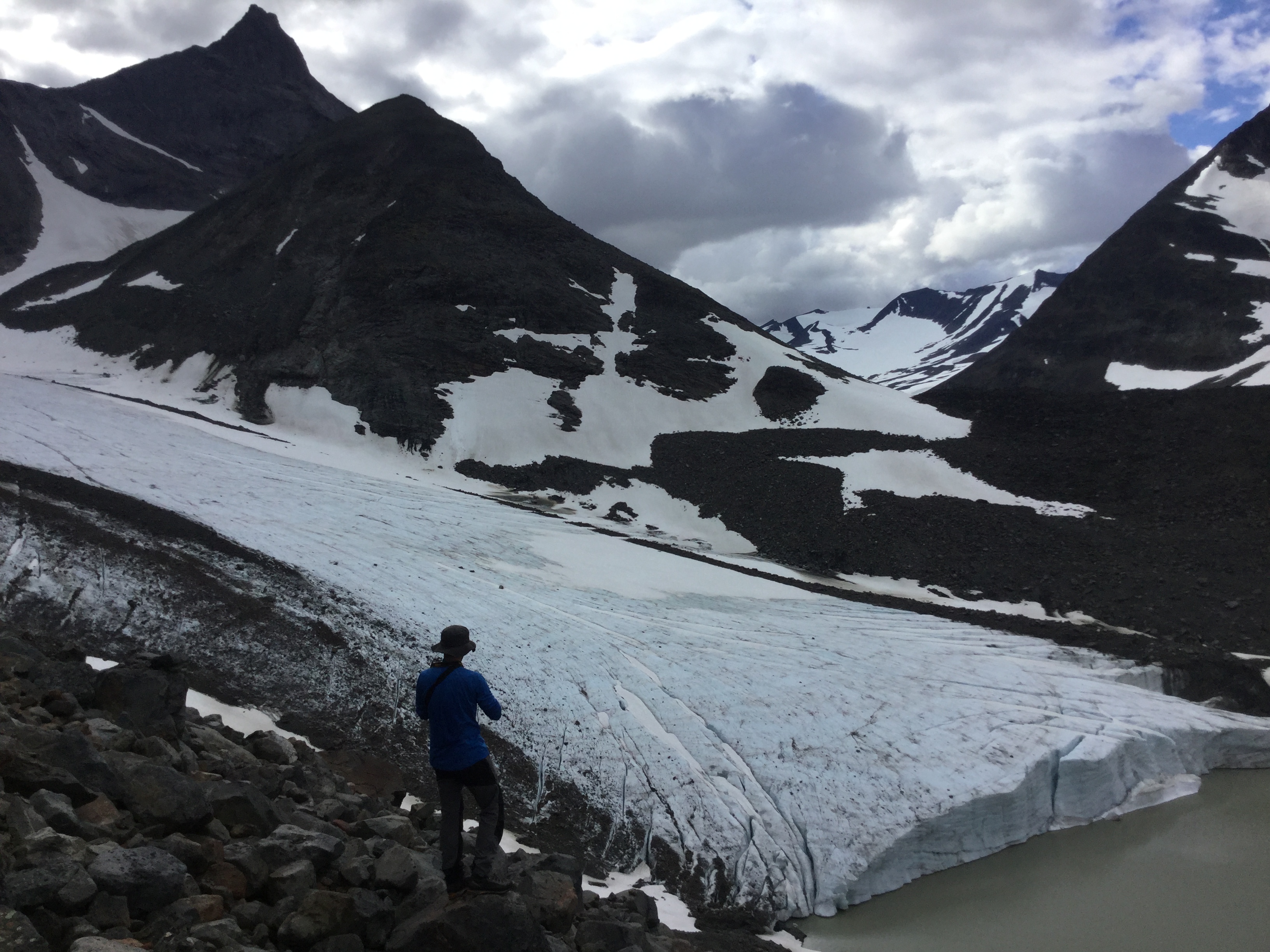July 2022 GLRETA Arctic Fieldwork Report
We had planned to arrive in the Arctic in the narrow window between Kas’ proglacial lake becoming ice free and the first warm event of the summer, so that we could measure the lake temperatures as they changed as the summer progressed. Unfortunately summer was already well underway as the first real warm event of the season occurred before we arrived, which also seemed to bring numerous mosquitoes with it. In previous trips I had not encountered mosquitoes at our base camp 1000m up in the Arctic/Alpine environment of the Kebnekaise mountains in Sweden. They were not the only signs of warming in the landscape, as our first night trying to sleep in 24 hour daylight (tricky in a tent) was further disturbed by a couple of rather large rockfalls from the surrounding mountains.


After a somewhat ‘testing’ journey with a substantial amount of baggage, we still had enough energy to scramble over the moraines and see how the glacier front had changed since I saw it 3 years ago. The usual moments of ‘bittersweet’ emotions as the scientist keen to understand a dynamic environment, whilst the environmentalist in me didn’t want to see how much the glacier had retreated. The moraines and environment around the glacier did seem greener, with areas of bare sand now mostly moss covered as well as grass and small Willows becoming more established on the moraines, which also made the going much easier underfoot. The stabilisation of the moraine from vegetation was certainly appreciated and enabled good view points to be accessed more easily.

The glacier front had changed quite substantially since I last saw it in September 2019, the large cave in the centre had gone and the majority of the front was less steep, with rounded features that suggested melt processes above water had dominated. The absence of any angular ‘fresh’ cavities on the front confirmed that we had arrived before any icebergs had calved this summer. The large thermally eroded notch running across the full length, suggested that it would not be too long before iceberg calving began… Prominent crevasses behind the central section of the front suggested that a substantial block was waiting to calve from the front, so boaty II was deployed a ‘relatively’ safe distance (20m) away and recorded near surface temperatures of 3 C and a maximum depth of 20m at the ice front, much warmer than I had expected for early July. It was clear that the proglacial lake temperatures and influence on the glacier morphology and retreat rates needed further investigation in what appears to be another eventful third field season.


Working on proglacial lakes can be ‘rather challenging’ most of the time, but occasionally you are gifted with weather windows when it’s ‘all systems go’ in order to get as much data as possible. There was no time for resting after the journey and repeated load hauling (shifting 100kg of baggage through 5 coaches of a busy train isn’t fun) as we installed time lapse cameras, weather station and calibrated thermistors before readying the inflatable kayak for launch. The cold (6 C) cloudy morning morphed into a relatively sunny afternoon and changing into a wetsuit by the side of a cold sediment filled glacial lake in the Arctic was starting to seem less of a crazy idea. Once we’d got our main temperature string installed (with a robust marine buoy…) it even started to seem like a good idea, which may come off if it survives a summer season of icebergs bombarding it and hopefully captures the lake response to whatever summer 2022 throws at it… We paddled on towards the glacier and dropped another thermistor string as close to the front as we dared risk with the impending iceberg blocks waiting to calve about 100m away. It was a relief to be heading away from the glacier and it almost felt pleasant as we drifted away to safety and managed to get another thermistor string stuck in the rocks at the far end of the lake.

We returned to the glacier front the following day and whilst Miles mapped the lake bathymetry in front of the glacier, Mike dropped some fluorescein dye into streams on top of the glacier. It seemed inevitable that Dr Dye had to use dye tracing at some point, but also proved to be very useful in seeing how meltwater enters the lake and drives currents along the glacier front, which further enhance the thermal undercutting and iceberg calving rates. We also discovered meltwater upwelling in the glacier up to ~5m above the lake level. Why was meltwater being pushed up this high? How would this affect the glacier front? What would happen when rainfall events pumped water through the system? As I typed this it was 3 C and raining/sleating heavily outside. I wouldn’t like to predict what the summer season will bring for Kas’ glaciar this year. It seems pretty crazy that we are now preparing to leave the Arctic and return to temperatures over 30 C in the UK… Hopefully the heatwaves won’t happen in the Arctic this year… We’ll find out how Kas’ glaciar has changed later in the summer and compare the surface changes to other glaciers in the neighbouring area. Watch this space!

